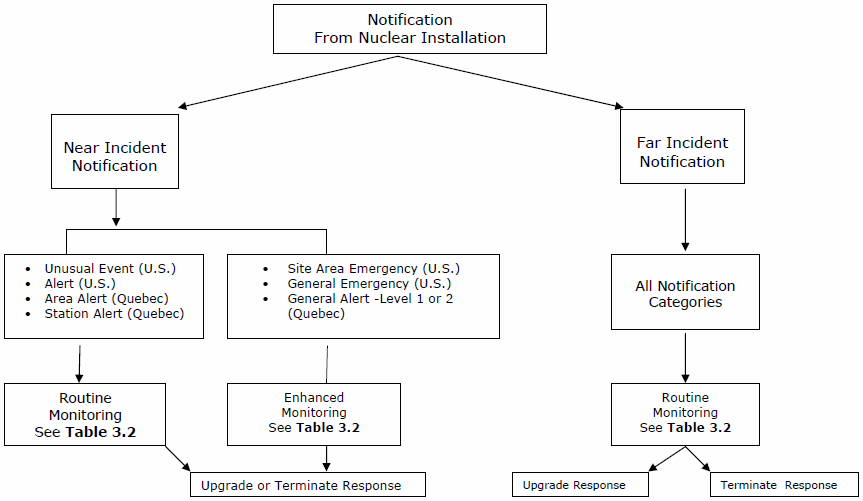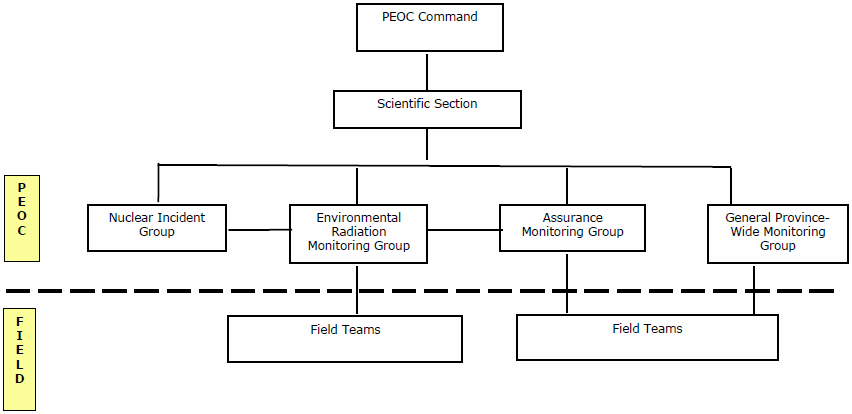Chapter 3 Notification and initial response
3.1 Initial Notification
3.1.1 Near Incident
- Under the agreements entered into by Ontario with adjoining Near Incident jurisdictions, those jurisdictions will notify the PEOC whenever one of their nuclear installations initiates an emergency notification. (In some cases notification of the lowest level event will not be made).
- A backup notification should also be received by the PEOC from the Government of Canada (Public Safety Canada).
- The notification categories used by the Near Incident sites are explained in Annex D.
3.1.2 Far Incident
- Official notification of a Far Incident will be received by the PEOC from the Government of Canada (Public Safety Canada).
- The information likely to be contained in such a notification is covered in Annex D.
- It is conceivable that the first indication of the occurrence of a Far Incident may be a report by the media, in which case the PEOC shall seek confirmation from Public Safety Canada of any such events.
3.2 Initial Response
3.2.1 The initial response to a notification of a transborder incident is shown in Figure 3.1.
3.2.2 The main actions required to be taken under each type of initial response level are given in Table 3.2.
3.2.3 The response level initially adopted, or in effect at any time, can be changed to another level, if considered appropriate, by the PEOC. All concerned or affected shall be notified of any such change.
3.2.4 The response to a transborder incident may be terminated, when considered appropriate, by the PEOC and all concerned shall be informed.
3.3 Internal Notifications
3.3.1 Whenever the PEOC receives a notification resulting in Routine Monitoring, the normal PEOC Duty Staff procedures shall apply.
3.3.2 Whenever the PEOC adopts Enhanced Monitoring, the appropriate staff will be notified, as follows:
- Command
- Commander
- Chief, Operations
- Chief Scientist
- Chief, Emergency Information
- Emergency Information staff
- MOHLTC Representative
- Emergency Management Assistant
- Operations Section
- Chief, Operations
- Operations Officers
- Emergency Management Assistants
- Community Assistance Team
Provincial ministries and Federal departments that could be required include:
Provincial ministries:
- OMAFRA
- MOHLTC
- MNR
- MOE
- MOL
- MTO
- OPP Duty Office
Federal departments:
- Public Safety Canada
- Health Canada
- Canadian Nuclear Safety Commission
Other Representatives:
- as deemed appropriate
- Elements of the Scientific Section
(see Section 5.5 and Figure 3.3):
- Chief Scientific Section
- Environmental Radiation Monitoring Group
- Assurance Monitoring Group
- General Province-Wide Monitoring Group
- Others, as deemed appropriate
3.3.3 Other Organizations
Each ministry/jurisdiction/organization receiving a notification of plan activation should issue an appropriate internal notification to its agencies and individuals who are required to respond.
In some cases, ministries may need to activate their MEOCs.
3.4 External Notifications
When the PEOC receives notification of a Near Incident requiring adoption of Enhanced Monitoring, it shall notify the following departments within the Federal government:
- Health Canada
- Public Safety Canada
- Canadian Nuclear Safety Commission
- Canadian Coast Guard
3.5 Implementation of Transborder Plan
This Transborder Implementing Plan shall be implemented whenever the PEOC receives notification of a Transborder incident that may affect Ontario.

| Response level | Main actions to be taken |
|---|---|
| Routine monitoring (ref: Chapter 4) |
|
| Enhanced monitoring (ref: Chapter 5) |
|
